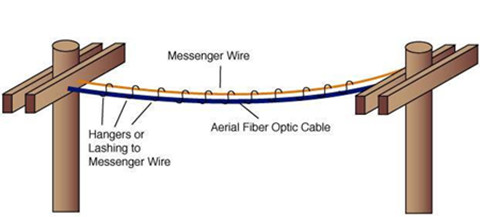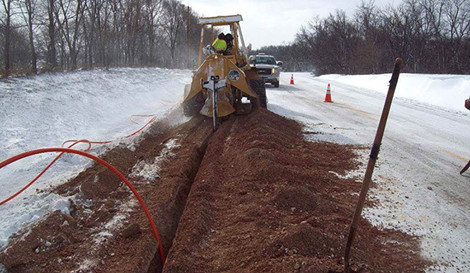In the fiber optic network, a carefully constructed network requires calculated planning and a high level of installation. It is not as easy a cavemen can do it, as many factors should be taken into account when installing a fiber optic network, such as construction costs, time constraints, existing infrastructure, and so on. There are two main types of land based network fiber optic installation—aerial and underground. This article will talk about these two cable installations in detail.
Aerial Fiber Construction
The fiber optic installation that occurs when fiber jumper is installed along a line of utility poles, is known as aerial fiber construction. When installing a placing aerial cable, besides the cables, a support strand is needed as well. A support strands can be deployed along the route first, with fiber pulled and lashed to the support strand later. Or the aerial fibers can be pre-lashed, making the installation less complex. Lashing refers to the process of securing the fiber cable to the support strand via lashing wire. When placing cable on a pole, the required spacing distance varies depending on the type of cable or equipment. These requirements are often set by local, state and national standards.

Underground Fiber Construction
Underground fiber construction refers to the fiber installation that occurs when fiber optic cable is installed under the ground in pipes, or conduits. The depth of the underground cables varies by many factors; however, it is typically between 12-36 inches below surface level. In underground fiber construction, the fiber optic cables are buried in a trench, but In colder areas, fiber cables are buried below the frost line to protect the cables from being damaged.

There are three main subcategories of underground fiber installation including direct buried, air-blown or micro trenching. In a direct buried cable construction, the fiber optic cable is installed directly into the ground rather than in protective conduits. When fiber optic cable is installed through a conduit via air, the process is known as air-blown or cable-jetting construction. And in air-blown installation, a device injects a high volume of air into the duct at high pressures to blow the cable through. Micro trenching construction occurs when the fiber optic cable is installed underground by way of a small groove, instead of a larger trench. Each of the above underground installations have a variety of benefits and are used in varying, and case specific scenarios.
Pros and Cons of Aerial and Underground Deployment
Aerial cables are one of the most preferred and cost-effective solutions for the end user, because installers can reuse existing pole infrastructure without digging up another roads to bury cables or ducts, what’s more, aerial cable construction is easily modified to add additional capacity.
However, aerial deployment is more susceptible to damage. The falling tree branches, high winds or ice storms, vehicle accidents, animals that chew on the fiber all can make the aerial cable strain or break. Therefore, calculations on the strength of both the cable and poles need to be taken into account when determining span lengths.
But it will typically takes some time and money to make ready requirements if poles and cable need to be made stronger. It is a good solution to the areas with existing pole networks or rural environments without urban restrictions.
While many customers do prefer their services, including fiber cables, to be installed underground. Unlike the aerial deployment, buried fiber deployments are less susceptible to wind and ice damage as they are buried below the layer, which makes it often at least ten times more reliable than aerial routes, especially where poor weather is common.
However this might be a costly solution because the cable needs to be buried deep in the ground to protect it from accidental damage. The deeper an operator has to dig, the more costly it is. Never to mention that if a buried direct cable is broken, it is expensive to repair. These buried direct cables cannot be removed and replaced because it tends to be firmly anchored into the ground.
Conclusion
As this blog shows, choose which method to install a fiber optic network will depend on a variety of factors including the landscape, cost of the labor and equipment, and so on. Both of the two deployment methods presents advantages and disadvantages that must be carefully evaluated by case basis. FS.COM offers a variety of fiber optic cables that can be used in different applications. The optical cables terminated with optical connectors like LC to FC patch cord have been widely utilized in fiber optic network. For more on the fiber optics provided by FS.COM, please contact us directly.

IMPRESSED WITH SUCH A GOOD CONTENT!!
ReplyDeleteVERY INTERESTING
GREAT WORK
Fiber optic network cabling
fiber optic solutions in dubai
Thank you for the information Fiber optic network cabling
ReplyDeleteThank you for the information structured cabling service
ReplyDelete